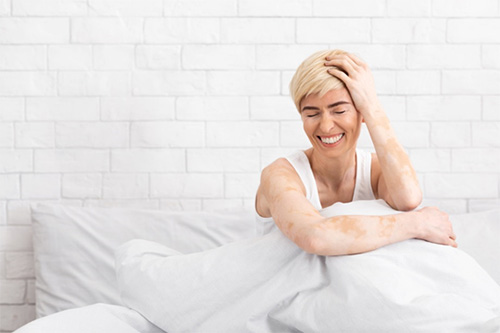Authored by Dr. Amber Hayden, DO
For years we’ve talked to many women who have become frustrated and disheartened by recurrent vaginal yeast infections. Many of these women have been to just about every practitioner on the planet and were told, “Well, some people just have this problem and there isn’t much we can do about it.” But, yes, there is something you can do about it. There’s a natural solution for vaginal yeast — and it starts with changing the terrain in the vagina and in the body.

The normal vagina has a balance of healthy bacteria and other microorganisms, some of which are Candida albicans — the yeast most commonly involved in yeast infections. Keeping a healthy balance of these organisms is perhaps the most important aspect of naturally resolving yeast infections. If the balance is lost — and several things can upset it — Candida may be allowed to overgrow to the point of causing symptoms.
Symptoms of vaginal yeast overgrowth
- Redness and inflammation of genital area
- Itching and irritation
- Whitish to grayish-white discharge that resembles cottage cheese
- Painful intercourse
- Burning urination
- “Yeasty” odor
The wonderful news is that we can rebalance your vaginal flora so that yeast overgrowth isn’t an issue — now or in the future. Whether you are suffering from recurrent vaginal yeast infections or experiencing your first infection, there are ways for you to change the terrain naturally. Let’s take a closer look.
How does a vaginal yeast infection start?
There are several factors that contribute to vaginal yeast overgrowth and if a woman is aware of them, she has the knowledge to prevent possible future infections. Here are some things to think about as possible contributors to yeast overgrowth:
- Use of antibiotics. There is a direct relationship between antibiotic use (or overuse) and yeast infections. Most antibiotic drugs do not specify their target organism, but end up killing healthy and pathogenic bacteria. Friendly bacteria such as lactobacilli help to maintain a more acidic pH in the vagina , which fends off problematic yeast and bacteria. After a course of antibiotics, there are fewer lactobacilli and the vaginal pH may become more alkaline, giving competitive yeast an opportunity to grow.
- Hormonal shifts. We know that changing hormones can influence the environment of your vagina, making it more or less amenable to yeast overgrowth. Such changes occur monthly with the menstrual cycle, but also in response to other hormonally dynamic conditions such as pregnancy, diabetes, perimenopause and menopause.
Can yeast be transmitted through sex?
Depending on their symptoms, many women don’t feel much like having intercourse when they have a yeast infection. But some do, and wonder if they can transmit their yeast infection to their partners or if they may have acquired a yeast infection from a partner. For the most part, transmitting a yeast infection is uncommon, but partners may notice some redness and itching.
Approximately three out of four women will experience a yeast infection (vulvovaginal candidiasis, or VVC) at least once in their lives. About 5–8% will have more than four episodes within a year, a condition designated as recurrent vulvovaginal candidiasis (RVVC). VVC is not traditionally considered a sexually transmitted disease, but on occasion, sexual transmission of Candida can occur. In a study of heterosexual couples, in only a few cases was genetically similar Candida species recovered from both partners.
Some women notice symptoms of yeast infections at distinct times of the month, often in the week before their period starts or right after it starts. Oral contraceptives, which are synthetic hormones, can likewise disrupt the normal cyclic changes in vaginal flora, decreasing acids and creating a more favorable yeast microclimate.
Estrogen is another factor that increases vaginal fluid secretion and helps to keep genitourinary tissues (including the urethra and vagina) moist. As estrogen production diminishes, the tissues may thin and become more susceptible to infection. Such changes in a woman’s hormonal status as she enters perimenopause, or sometimes later, after her periods cease, may lead her to develop bladder and/or yeast infections. Compounded bioidentical estriol, especially when suspended in a base of purified emu oil, can be wonderful for plumping the tissues, soothing inflammation, and reducing vulnerability to both bacterial and yeast overgrowth.
- Frequent douching and use of other “feminine hygiene” products. Douching has the effect of disrupting normal vaginal secretions and vaginal pH. Conventional douching products, especially those that contain artificial fragrance, foaming agents and dyes, are notoriously harsh on the delicate chemical balance in the vagina. While there may be limited circumstances where using yogurt can help relieve vaginal yeast (see below for details), it’s generally not a good idea to douche or use feminine deodorant sprays on a routine basis.
- Frequent sex. Women sometimes notice that having frequent sex with a male partner coincides with having frequent yeast infections. This association may come about because the presence of semen is altering the vaginal environment. Semen itself is alkaline in pH, so frequent heterosexual intercourse can make the vaginal terrain more alkaline and somewhat more vulnerable to yeast. Sex is not a major cause of vaginal yeast in most women, but rather a contributing factor that makes it easier for yeast to become established (see our box on yeast transmission through sex).
- Immunity traits. As mentioned above, Candida albicans is a yeast typically present in low levels in the vagina (and gut) of many healthy women. Depending on a woman’s unique set of genes and her immune system, protection from recurrent candidiasis may vary from woman to woman. Though researchers are still learning about our defense mechanisms, they continue to uncover fascinating aspects of our immune systems, which on the one hand protect us from pathogens like yeast, but on the other may leave some of us somewhat more vulnerable. Knowing yourself — how your body responds to your everyday way of life — can make all the difference in prevention.
Over and over again — thoughts on recurrent yeast infections
The terrain that favors yeast in the digestive tract favors it elsewhere in the body, and yeast from the digestive tract can readily find its way into the vagina. If it seems like you treat one yeast infection only to end up with another one the next month or week, you may want to give some consideration to the environment in your body.
Yeast is an opportunistic organism that will proliferate if the surroundings are right. If you eat food with lots of refined carbs and low micronutrient content, it can create ideal conditions for yeast to proliferate. The change in the gut environment can allow yeast to predominate, and then the high-sugar foods provide fuel for the population boom. But you can get good results by rebalancing intestinal flora, and eating a short-term yeast-free diet.
As mentioned above, some women may be more susceptible to yeast depending on their immune system, so we encourage you to get to know your body. The good news is, even if you’re prone to yeast overgrowth, you can learn how to give yourself the extra care and attention needed to prevent future infections. You can see wonderful results by simply changing the terrain in the body and supporting a balanced immune response.
Vaginal yeast solutions — get to the source
Rather than going back and forth to the pharmacy or drug store for antifungals, let’s take a look at some natural ways to eliminate yeast overgrowth so it goes away and stays away. Here’s what we suggest:
Many antifungals work by interfering with the production of the membrane that surrounds a fungal cell or certain enzymes. It’s possible for yeast to become resistant to antifungal drugs though, so it is sometimes necessary to switch to a different one.
A good place to start is with OTC Monistat (miconazole), or prescription oral Diflucan or Trican (fluconazole). Nizoral (ketoconazole) is another prescription option, but it’s somewhat more toxic, so it is not usually our first choice, and resistance to this drug has also been observed. Nonetheless, sometimes a switch will clear up the yeast.
- Eat more fiber, healthy fats and protein. Eliminate refined carbohydrates, certain fruits and other yeast-promoting foods. Most likely you will not have to remain indefinitely on the diet — just until you’ve effectively reset your internal terrain. Then you may be able to reintroduce yeast-friendly foods in reasonable amounts.
- Add a high-quality probiotic. The terrain of your vagina can certainly benefit from more healthy bacteria. A quality probiotic like the one we offer is packed with all the good bacteria your body needs to support health and regain healthy vaginal floral balance.
- Consider a yogurt dip. Dip a tampon into freshly opened, plain (unsweetened), organic yogurt, then insert it into the vagina for 10 minutes, twice a day. This can help recolonize the vagina with healthy lactobacilli, which can then crowd out the yeast.
- Support your immune system. Taking a pharmaceutical-grade multivitamin-mineral like the one we offer will help provide your system with the nutrients needed to maintain immunity. Other ways to support your basic immunity include drinking plenty of pure water, getting 7–8 hours of sleep per night, and doing your best to limit stress.
- Talk to a trusted practitioner. If your symptoms persist or recur and the situation warrants it, talk to your practitioner about stronger over-the-counter or prescription antifungal options. You may want to see a functional medicine or naturopathically inclined ob/gyn practitioner for expert guidance in eliminating vaginal candidiasis. Our article on systemic yeast lists some natural antifungals, that can give many women relief from recurrent yeast infections.
For so many women, it may seem like Monistat or Diflucan are going to become permanent fixtures on their bathroom shelves, but try not to get discouraged. Getting to the source of the issue is what we’ve found to be most helpful and effective for yeast infections in the women we talk to. Natural measures like changing your diet and supporting your immune system can often arrest yeast overgrowth, resolve symptoms and prevent recurrence. There are things you can do to resolve yeast infections naturally and for good — and when you need extra support, we’re here to guide you along the way.
1 Pirotta, M., & Garland, S. 2006. Genital Candida species detected in samples from women in Melbourne, Australia, before and after treatment with antibiotics. J. Clin. Microbiol., 44 (9), 3213–3217. URL (abstract): https://jcm.asm.org/cgi/content/abstract/44/9/3213 (accessed 08.30.2010).
2 Juárez Tomás, M., et al. 2003. Growth and lactic acid production by vaginal Lactobacillus acidophilus CRL 1259, and inhibition of uropathogenic Escherichia coli. J. Med. Microbiol., 52 (12), 1117–1124. URL: https://jmm.sgmjournals.org/cgi/content/full/52/12/1117 (accessed 08.30.2010).
Paavonen, J. 1983. Physiology and ecology of the vagina. Scand. J. Infect. Dis. Suppl., 40, 31–35. URL (abstract): https://www.ncbi.nlm.nih.gov/pubmed/6582587 (accessed 08.30.2010).
3 Segal, E., et al. 1984. Correlative relationship between adherence of Candida albicans to human vaginal epithelial cells in vitro and candidal vaginitis. Sabouraudia, 22 (3), 191–200. URL (abstract): https://www.ncbi.nlm.nih.gov/pubmed/6379915 (accessed 09.09.2010).
“…Our findings point to increased C. albicans adherence in situations where there is an increase in the number of intermediate epithelial cells: pregnancy, the first or fourth weeks of the menstrual cycle, or diabetes….”
4 Yoganathan, S., et al. 2003. Antagonism of croton oil inflammation by topical emu oil in CD-1 mice. Lipids, 38 (6), 603–607. URL (abstract): https://www.ncbi.nlm.nih.gov/pubmed/12934669 (accessed 09.09.2010).
Politis, M., & Dmytrowich, A. 1998. Promotion of second intention wound healing by emu oil lotion: Comparative results with furasin, polysporin, and cortisone. Plast. Reconstr. Surg., 102 (7), 2404–2407. URL (abstract): https://www.ncbi.nlm.nih.gov/pubmed/9858176 (accessed 09.09.2010).
Whitehouse, M., et al. 1998. Emu oil(s): A source of non-toxic transdermal anti-inflammatory agents in aboriginal medicine”. Inflammopharmacology, 6 (1), 1–8. URL (abstract): https://www.ncbi.nlm.nih.gov/pubmed/17638122.
5 Harraway, C., et al. 2000. Semen pH in patients with normal versus abnormal sperm characteristics. Am J. Obstet. Gynecol., 182 (5), 1045–1047. URL (abstract): https://www.ncbi.nlm.nih.gov/pubmed/10819822 (accessed 08.30.2010).
Haugen, T., & Grotmol, T. 1998. pH of human semen. Int. J. Androl., 21 (2), 105–108. URL (abstract): https://www.ncbi.nlm.nih.gov/pubmed/9675619 (accessed 08.30.2010).
6 Fidel, P. 2005. Immunity in vaginal candidiasis. Curr. Opin. Infect. Dis., 18 (2), 107–111. URL (abstract): https://www.ncbi.nlm.nih.gov/pubmed/15735412 (accessed 08.30.2010).
SUMMARY: Instead of vulvovaginal candidiasis being caused by defective or dysfunctional CD4 T helper 1-type cell-mediated immune reactivity, data suggest that symptomatic vulvovaginal candidiasis is associated with an aggressive response by polymorphonuclear neutrophils, whereas protection appears to be innate and noninflammatory. The role for innate immunity in both protection against, and promotion of, symptomatic vulvovaginal candidiasis is paradigm changing.
Fidel, P., et al. 2004. An intravaginal live Candida challenge in humans leads to new hypotheses for the immunopathogenesis of vulvovaginal candidiasis. Infect. Immun., 72 (5), 2939–2946. URL: https://iai.asm.org/cgi/content/full/72/5/2939?view=long&pmid=15102806 (accessed 08.30.2010).Kulkarni, D., &Venkatesh, D. 2004. Non-secretor status: A predisposing factor for vaginal candidiasis. Indian J. Pharmacol., 48 (2), 225–229. URL (abstract): https://www.ncbi.nlm.nih.gov/pubmed/15521563 (accessed 08.30.2010).
Thom, S., et al. 1989. Non-secretion of blood group antigens and susceptibility to infection by Candida species. FEMS Microbiol. Immunol., 1 (6–7), 401–405. URL (abstract): https://www.ncbi.nlm.nih.gov/pubmed/2631880 (accessed 08.30.2010).
References regarding transmission of yeast through sex
a Ono, F., & Yasumoto, S. 2009. Genital candidiasis. Nippon Rinsho, 67 (1), 157–161. URL (abstract): https://www.ncbi.nlm.nih.gov/pubmed/19177766 (accessed 08.27.2010).
b Lisboa, C., et al. 2010. Genital candidosis in heterosexual couples. J. Eur. Acad. Dermatol. Venereol. [Epub ahead of print.] URL (abstract): https://www.ncbi.nlm.nih.gov/pubmed/20546387 (accessed 08.27.2010).










